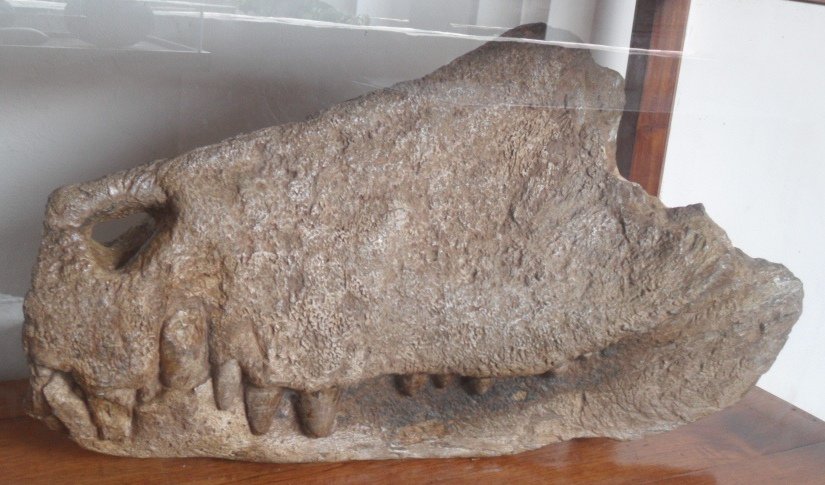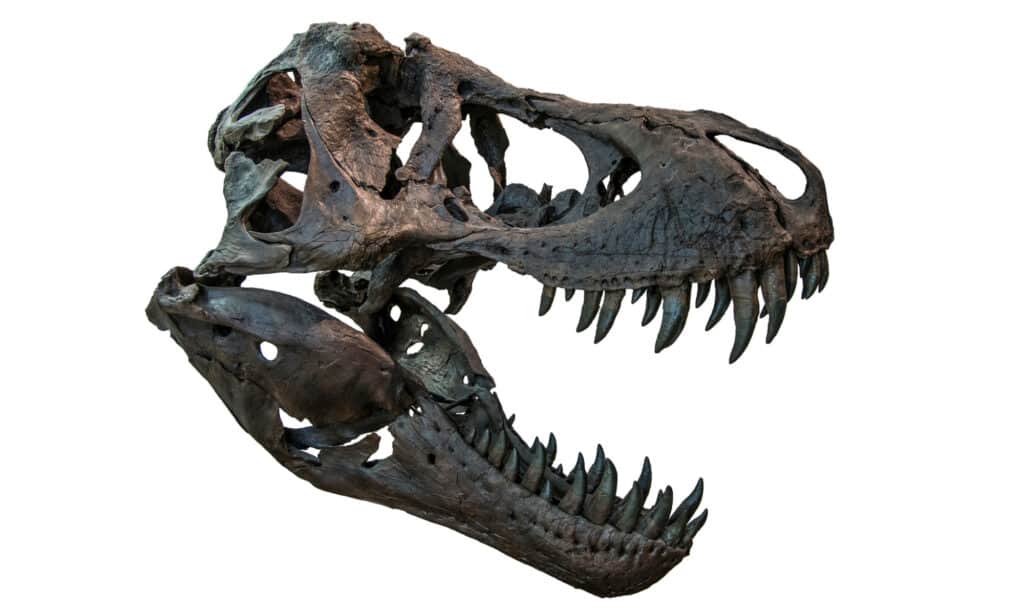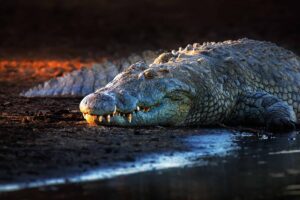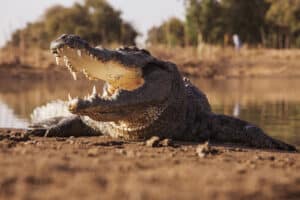Crocodiles and their related species have been around for a long time. In fact, many consider crocodiles to be living fossils with how much they’ve survived in order to make it. Through the millions of years they have been around, there have been some really unique species. Most of these strange species have evolved and disappeared, only to be seen in the fossil record. One recent example of this is a crocodylomorph that stood as tall as a human! Let’s discover the ancient crocodile that would have towered over humans if we had been around!
Barinasuchus: The Largest Land-Dwelling Crocodylian to Ever Live

Barinasuchus was one of the largest land-dwelling “crocodiles” in history and likely stood as tall as a human.
©Museo A.A.T Barinas / CC BY-SA 3.0 – License
When we think of crocodiles, we generally think of an aquatic reptile that spends its time in the water or sunning itself on the shoreline. For a human, it’s pretty easy to avoid a croc – simply avoid the water! While that may be the case today, that wasn’t how things always were. In fact, one type of crocodile, Barinasuchus, lived on land and was as tall as a human.
Barinasuchus is an extinct crocodylian reptile that lived in modern-day Argentina and Brazil. The name translates to “the Barinas crocodile”, which is a reference to the place where the original fossil was found. Part of what makes Barinasuchus so interesting isn’t its size or body type, but the combination of the two.
The reason Barinasuchus is so Scary
Based on the remains, scientists estimate that Barinasuchus would have been around 20-25 feet long and weighed 3,800 lbs. Additionally, this crocodylian would have stood over a meter tall, probably around the size of a human (~5 feet). For reference, the largest species of crocodile today, the saltwater crocodile, usually measures 20 feet and weighs around 2,200 lbs. Even the largest, record-breaking saltwater crocodiles don’t measure up to the upper average of Barinasuchus.
Based on size alone, Barinasuchus is pretty scary, but there is another element that takes it to a different level. Barinasuchus belonged to a now-extinct genus of mesoeucrocodylians known as sebecids. Sebecids were terrestrial crocodiles, meaning they lived and hunted on land.
Essentially, Barinasuchus was a land-dwelling predator that was the height of a man, weighed over 3,000 lbs, and was 25 feet long. On top of that, Barinasuchus had some of the nastiest teeth in the animal kingdom.
Barinasuchus and its Ziphodont Teeth

The ziphodont teeth of Barinasuchus made it a very formidable predator.
©iStock.com/rkristoffersen
Another dimension to Barinasuchus‘ fear-factor was its teeth. Barinasuchus has a large skull filled with ziphodont teeth that were extremely similar to other theropods. For reference, theropods were some of the scariest predators on earth and included Tyrannosaurus, Allosaurus, and Velociraptor.
Ziphodont teeth are characterized as being compressed and thin with a backward-facing curve, Additionally, the teeth have serrated edges, perfect for ripping flesh. The size, terrestrial nature, and deadly teeth of Barinasuchus made it one of the most formidable predators of its time.
Where did Barinasuchus live?
The original fossil for Barinasuchus was discovered in Barinas, Venezuela, hence the name. The first fossil discovered was the skull of Barinasuchus which was found in the Parangula Formation. Since the holotype fossil’s discovery, other fossils have been found in Argentina, Peru, and other locations in Venezuela.
Barinasuchus would have lived across the modern-day South American continent during the Cenozoic era (the earth’s current geologic era spanning the past 66 million years). Based on the findings, Barinasuchus likely lived around 42 million years ago, going extinct around 11.8 million years ago. During this period, sebecids were spread across the South American continent and were an incredibly diverse group.
What did Barinasuchus eat?
Knowing the region and time frame that Barinasuchus lived in gives us some clues as to what they ate. Overall, Barinasuchus was an apex predator that lived and hunted other creatures on land. Additionally, the size and teeth of Barinasuchus would have allowed it to take down nearly any mammal that lived in the region without much trouble.
Common animals in the region would have been somewhat similar to the modern tapir and other ungulates. The most common prey species would have likely included Macrauchenia, a group of camel-like animals with small trunks, Phoberomys, a group of giant rodents that are the ancient descended of guinea pigs, and Hapalops, primitive ground sloths.
The only threats that Barinasuchus would have faced would have come from other Barinasuchus‘, and potentially the Purussaurus. Purussaurus was a species of giant caiman that grew upwards of 35 feet and weighed nearly 6 tons. Still, Purussaurus was an aquatic predator, while Barinasuchus was terrestrial.
The photo featured at the top of this post is © di Lissandro/Shutterstock.com
Thank you for reading! Have some feedback for us? Contact the AZ Animals editorial team.






